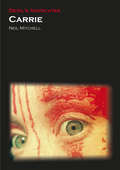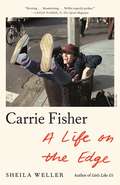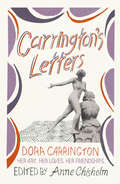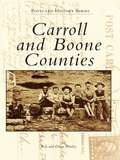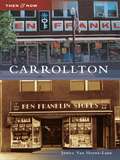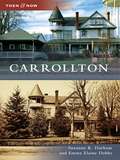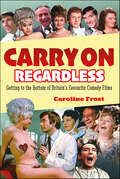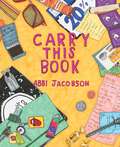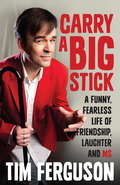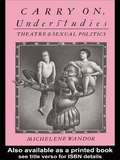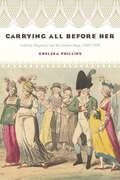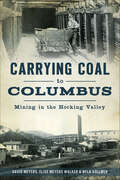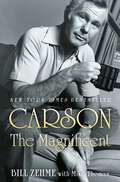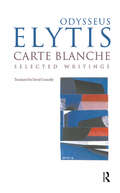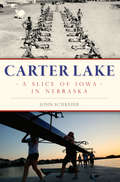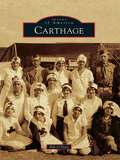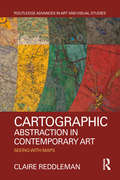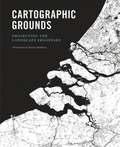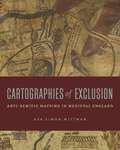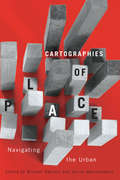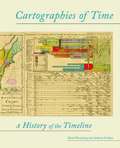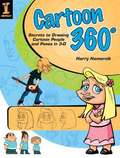- Table View
- List View
Carrie
by Neil MitchellNot only breaks the film down into its themes, stylistic tropes, technical approaches, uses of color and sound, dialogue, and visual symbolism but also considers a multitude of other factors contributing to the work's classic status
Carrie
by Neil MitchellNot only breaks the film down into its themes, stylistic tropes, technical approaches, uses of color and sound, dialogue, and visual symbolism but also considers a multitude of other factors contributing to the work's classic status
Carrie (Devil's Advocates Ser.)
by Neil MitchellBrian De Palma's adaptation of Stephen King's debut novel, Carrie (1976), is one of the defining films of 1970s "New Hollywood" style and a horror classic. The story of a teenage social outcast who discovers she possesses latent psychic powers that allow her to deliver retribution to her peers, teachers, and abusive mother, Carrie was an enormous commercial and critical success and is still one of the finest screen adaptations of a King novel. This contribution to the Devil's Advocates series not only breaks the film down into its formal componenets--its themes, stylistic tropes, technical approaches, uses of color and sound, dialogue, and visual symbolism--but also considers a multitude of other factors contributing to the work's classic status. The act of adapting King's novel for the big screen, the origins of the novel itself, the place of Carrie in De Palma's oeuvre, the subsequent versions and sequel, and the social, political, and cultural climate of the era (including the influence of second wave feminism, loosening sexual norms, and changing representations of adolescence), as well as the explosion of interest in and the evolution of the horror genre during the decade, are all shown to have played an important part in the film's success and enduring reputation.
Carrie Fisher: A Life On The Edge
by Sheila WellerA remarkably candid biography of the remarkably candid—and brilliant—Carrie FisherIn her 2008 bestseller, Girls Like Us, Sheila Weller—with heart and a profound feeling for the times—gave us a surprisingly intimate portrait of three icons: Carole King, Joni Mitchell, and Carly Simon. Now she turns her focus to one of the most loved, brilliant, and iconoclastic women of our time: the actress, writer, daughter, and mother Carrie Fisher. <P><P>Weller traces Fisher’s life from her Hollywood royalty roots to her untimely and shattering death after Christmas 2016. Her mother was the spunky and adorable Debbie Reynolds; her father, the heartthrob crooner Eddie Fisher. When Eddie ran off with Elizabeth Taylor, the scandal thrust little Carrie Frances into a bizarre spotlight, gifting her with an irony and an aplomb that would resonate throughout her life. We follow Fisher’s acting career, from her debut in Shampoo, the hit movie that defined mid-1970s Hollywood, to her seizing of the plum female role in Star Wars, which catapulted her to instant fame. We explore her long, complex relationship with Paul Simon and her relatively peaceful years with the talent agent Bryan Lourd. We witness her startling leap—on the heels of a near-fatal overdose—from actress to highly praised, bestselling author, the Dorothy Parker of her place and time. <P><P>Weller sympathetically reveals the conditions that Fisher lived with: serious bipolar disorder and an inherited drug addiction. Still, despite crises and overdoses, her life’s work—as an actor, a novelist and memoirist, a script doctor, a hostess, and a friend—was prodigious and unique. As one of her best friends said, “I almost wish the expression ‘one of a kind’ didn’t exist, because it applies to Carrie in a deeper way than it applies to others.” <P><P>Sourced by friends, colleagues, and witnesses to all stages of Fisher’s life, Carrie Fisher: A Life on the Edge is an empathic and even-handed portrayal of a woman who—as Princess Leia, but mostly as herself—was a feminist heroine, one who died at a time when we need her blazing, healing honesty more than ever.
Carrington's Letters: Her Art, Her Loves, Her Friendships
by Dora CarringtonCarrington's beguiling letters take us beyond the Bloomsbury group to discuss sexual mores, how to be an artist, and what it is to be truly oneself.Known only by her surname, Dora Carrington was the star of her year at the Slade School of Fine Art, and was friends with some of the greatest minds of her day, including Virginia Woolf, Rosamund Lehmann and Maynard Keynes. For over a decade she was the companion of homosexual writer Lytton Strachey, and - stricken without him- killed herself when he died in 1932. Though she never achieved the fame her early career promised, in her determination to live life according to her own nature – especially in relation to her work and her fluid attitude to sex, gender and sexuality – she fought battles that remain familiar and urgent today. Now, through her passionate, playful and honest letters, we can encounter the maverick artist and compelling personality afresh and in her own words.
Carroll and Boone Counties
by Ray Hanley Diane HanleyFrom the 1890s through the 1920s, the postcard was an extraordinarily popular means of communication, and many of the postcards produced during this "golden age" can today be considered works of art. Postcard photographers traveled the length and breadth of the nation snapping photographs of busy street scenes, documenting local landmarks, and assembling crowds of local children only too happy to pose for a picture. These images, printed as postcards and sold in general stores across the country, survive as telling reminders of an important era in America's history. This fascinating new history of Carroll and Boone Counties showcasesmore than two hundred of the best vintage postcards available.
Carrollton
by Janice Van Horne-LaneHaving first been called Centreville in the early 1800s, when the new county of Carroll was formed in 1833, it was decided to change the name to Carrollton. Just as the name has changed, so have many of the sites. With the help of vintage images from private collections and current photographs taken by Nicole K. Taggart, lifelong resident Janice Van Horne-Lane hopes to tell the story of this quiet Midwestern town before the now becomes then of future generations.
Carrollton (Then and Now)
by Emma Elaine Dobbs Suzanne K. DurhamCarrollton, in the rolling farmland of northwest Georgia, is a city with strong agricultural traditions and a streetscape surprisingly unchanged from the early 20th century.
Carry On Regardless: Getting to the Bottom of Britain's Favourite Comedy Films
by Caroline Mary Frost“A thoroughly enjoyable fact-filled romp . . . a must-read for any fan of the Carry On films.” —Daily MailThe completely updated story of Carry On, Britain’s largest film franchise, all the way from the gentle capers of the 1950s, through the raucous golden age of the 1960s, to its struggles in the decades that followed.We take a happy walk down memory lane to enjoy again Sid James’s cheeky chuckle, Kenneth Williams’ elongated vowels, Charles Hawtrey’s bespectacled bashfulness and Barbara Windsor’s naughty wiggle.It all seemed effortless, but exclusive interviews with the series’ remaining stars including Bernard Cribbins, Angela Douglas and Kenneth Cope shed new light on just how much talent and hard work went into creating the laughs. For the first time, the loved ones of some of the franchise’s biggest names—on and off screen—share their personal memories from this unique era.Was Carry On really as sexist, racist and bigoted as critics claim? Three of the films’ female stars explain why they never felt remotely exploited, plus we take a fresh look at some of the series’ biggest titles and discover that, in reality, they were far more progressive than their detractors would have you believe.Finally, with constant talk about new films, fresh productions and tantalizing speculation about a brand new era of Carry On, we ask—does this unique series still have legs?“Fascinating.” —Adrian Chiles“Essential reading for fans of the Carry On Films, which were deceptively ahead of their times” —Tracy-Ann Oberman
Carry This Book
by Abbi JacobsonNEW YORK TIMES BESTSELLERFrom the mind of Broad City&’s Abbi Jacobson, author of I Might Regret This, a wonderfully weird and weirdly wonderful illustrated look at the world around us—all through the framework of what we carry.&“Jacobson&’s art is warm, textured, and carefully composed, a little bit Maira Kalman and a little bit Roz Chast. It&’s also genuinely funny.&” —Vox With bright, quirky, and colorful line drawings, Jacobson brings to life actual and imagined items found in the pockets and purses, bags and glove compartments of real and fantastical people—whether it&’s the contents of Oprah&’s favorite purse, Amelia Earhart&’s pencil case, or Bernie Madoff&’s suitcase. How many self-tanning lotions are in Donald Trump&’s weekender? What&’s inside Martha Stewart&’s hand-knit fanny pack? What kind of protein bars does Michelle Obama hide in her tiny clutch at the White House Correspondents&’ Dinner? An instant New York Times bestseller, Carry This Book provides a humorous and insightful look into how the things we carry around every day make up who we are.
Carry a Big Stick: A Funny, Fearless Life of Friendship, Laughter and MS
by Tim FergusonA funny, poignant and inspirational story of widely acclaimed comedian, writer and producer, Tim Ferguson.Tim Ferguson was a star of the international comedy circuit. Along with Paul McDermott and Richard Fidler he was part of the edgy, provocative and very funny Doug Anthony Allstars (DAAS). In 1994 they were at the height of their powers, performing in a season at the Criterion Theatre on Piccadilly Circus. The three mates, who began busking on the streets of Canberra a decade earlier, had achieved their ambition to become the self-styled rock stars of comedy.Then, all of a sudden, Tim woke up one morning and his whole left side wouldn't work. He'd had a lurking suspicion that something was wrong and after more episodes he went to a doctor thinking he'd be told to change his diet and get more sleep. It wasn't so simple. An eventual diagnosis of multiple sclerosis (MS) meant an end to the frenetic, high-energy life he was living.Carry a Big Stick is a chance for Tim to tell his story. He wants to make people laugh but also give inspiration to all the people doing it hard. A lot of people keep MS to themselves because it's invisible. In Tim's case, he has the stick. 'It's such a visible sign that something's happened; it's just easier if people know.'Carry a Big Stick meanders through Tim's life, and explains how the boy who went to nine schools in 13 years got used to saying, 'Hi, I'm the new kid'. It will detail his ambitions to become an actor and how the Doug Anthony Allstars were born and went on to become what Rolling Stone called 'The 3 amigos from hell'. Diagnosis changed a lot of things but Tim's quick wit and sense of humour weren't affected. This inspiring memoir shows us that you can laugh in the face of adversity.
Carry on Understudies: Theatre and Sexual Politics
by Michelene Wandor`one hell of a seminal read ... Here is a book that grapples, with energy, ingenuity and terrific intellectual rigour, with a bewildering forest of issues around gender and politics ... illuminating, insightful, perceptive.' - Women's Review
Carrying All before Her: Celebrity Pregnancy and the London Stage, 1689-1800 (Performing Celebrity)
by Chelsea PhillipsThe rise of celebrity stage actresses in the long eighteenth century created a class of women who worked in the public sphere while facing considerable scrutiny about their offstage lives. Such powerful celebrity women used the cultural and affective significance of their reproductive bodies to leverage audience support and interest to advance their careers, and eighteenth-century London patent theatres even capitalized on their pregnancies. Carrying All Before Her uses the reproductive histories of six celebrity women (Susanna Mountfort Verbruggen, Anne Oldfield, Susannah Cibber, George Anne Bellamy, Sarah Siddons, and Dorothy Jordan) to demonstrate that pregnancy affected celebrity identity, impacted audience reception and interpretation of performance, changed company repertory and altered company hierarchy, influenced the development and performance of new plays, and had substantial economic consequences for both women and the companies for which they worked. Deepening the fields of celebrity, theatre, and women's studies, as well as social and medical histories, Phillips reveals an untapped history whose relevance and impact persists today.
Carrying Coal to Columbus: Mining in the Hocking Valley
by David Meyers Elise Meyers Walker & Nyla VollmerAs early as 1755, explorers found coal deposits in Ohio's Hocking Valley. The industry that followed created towns and canals and established a new way of life. The first shipment of coal rolled into Columbus in 1830 and has continued ever since. In 1890, the United Mine Workers of America was founded in Columbus. Lorenzo D. Poston became the first of the Hocking Valley coal barons, and by the start of the twentieth century, at least fifty thousand coal miners and their families lived and worked in Athens, Hocking and Perry Counties. Authors David Meyers, Elise Meyers Walker and Nyla Vollmer detail the hard work and struggles as they unfolded in Ohio's capital and the Little Cities of Black Diamonds.
Carson the Magnificent
by Bill ZehmeThe definitive biography of Johnny Carson, the entertainer who redefined late-night television and American culture, told through intimate insights and riveting accounts of his legendary career and complex personal life.In 2002, Bill Zehme landed one of the most coveted assignments for a magazine writer: an interview with Johnny Carson—the only one he&’d granted since retiring from hosting The Tonight Show a decade earlier. Zehme was tapped for the Esquire feature story thanks to his years of legendary celebrity profiles, and the resulting piece portrayed Carson as more human being than American TV icon. Following Carson&’s passing in 2005, Zehme embarked on an exhaustive nearly decade-long research journey, interviewing dozens of Carson&’s colleagues and friends to craft this &“immensely informative and insightful&” (The Minnesota Star Tribune) biography, although his efforts were halted by a cancer diagnosis. When he died in 2023 his obituaries mentioned the Carson book, with New York Times comedy critic Jason Zinoman calling it &“one of the great unfinished biographies.&” Yet the hundreds of pages Zehme managed to complete are astounding both for the caliber of their writing and how they illuminate one of the most legendary talk show hosts of all time: A man who brought so much joy and laughter to so many millions, but was himself exceedingly shy and private. Zehme traces Carson&’s rise from a magic-obsessed Nebraska boy to Navy ensign in World War II to a burgeoning radio and TV personality to, eventually, host of The Tonight Show—which he transformed, along with the entirety of American popular culture, over the next three decades. Without Carson, there would be no late-night television as we know it. On a much more intimate level, Zehme also captures the turmoil and anguish that accompanied the success: four marriages, troubles with alcohol, and the devastating loss of a child. In one passage, Zehme notes that when asked by an interview in the mid-&’80s for the secret to his success, Carson replied simply, &“Be yourself and tell the truth.&” Completed with the help from journalist and Zehme&’s former research assistant Mike Thomas, Carson the Magnificent offers just that: an honest assessment of who Johnny Carson really was.
Carte Blanche
by David Connolly Odysseas ElytesFirst Published in 1999. Odysseus Elytis (1911-1996) was born in Crete, and published his first poems in 1935. He established himself as one of the leading figures in the 'Generation of the Thirties'. As well as publishing seventeen collection of poetry and a number of translations from Ancient Greek, he created two large volumes of prose writings. In 1979 he was awarded the Nobel Prize for Literature. This book is illustrated with ten colour reproductions of collages and paintings by Elytis as well as selected writings.
Carter Lake: A Slice of Iowa in Nebraska (Brief History)
by John SchreierWhen a flood redirected the Missouri River in 1877, a small patch of Iowa landed in Nebraska—and a new town was born. Carter Lake incorporated as an independent city in 1930 as Iowa’s only community west of the Missouri River. But the town continued to face Nebraska’s continued annexation attempts and floods. The Flood of 1952 covered the town in three feet of water. Meanwhile, uncertainty over the state lines led gamblers to flock to Carter Lake for illicit dogfighting, cockfighting, boxing matches and alcohol. Celebrated journalist John Schreier illustrates how the border town once known for its illicit nightlife has evolved into a growing bedroom community beneath the Omaha skyline.
Carthage
by Bill O'NealFounded in a pine forest on the East Texas frontier, Carthage assumed the name of one of the greatest cities of the ancient world. Although Carthage, Texas, did not become a bustling metropolis, the community has enjoyed a long history as the type of stable town that forms the backbone of America. For more than a century and a half, residents have played roles--at times prominently--in the historical and cultural life of Texas and the nation. Carthage has produced decorated war heroes, internationally famous country music stars, a noted American historian, and a groundbreaking political figure. As the home of Tex Ritter, Gentleman Jim Reeves, Linda Davis, and the Texas Country Music Hall of Fame, the community has become a country music mainstay. Beyond its celebrities, however, Carthage has most importantly produced generation after generation of patriotic and hard-working men and women.
Cartographic Abstraction in Contemporary Art: Seeing with Maps (Routledge Advances in Art and Visual Studies)
by Claire ReddlemanIn this book, Claire Reddleman introduces her theoretical innovation "cartographic abstraction" – a material modality of thought and experience that is produced through cartographic techniques of depiction. Reddleman closely engages with selected artworks (by contemporary artists such as Joyce Kozloff, Layla Curtis, and Bill Fontana) and theories in each chapter. Reconfiguring the Foucauldian underpinning of critical cartography towards a materialist theory of abstraction, cartographic viewpoints are theorised as concrete abstractions. This research is positioned at the intersection of art theory, critical cartography and materialist philosophy.
Cartographic Grounds: Projecting the Landscape Imaginary
by Charles Waldheim Mohsen Mostafavi Jil DesiminiMapping has been one of the most fertile areas of exploration for architecture and landscape in the past few decades. While documenting this shift in representation from the material and physical description toward the depiction of the unseen and often immaterial, Cartographic Grounds takes a critical view toward the current use of data mapping and visualization and calls for a return to traditional cartographic techniques to reimagine the manifestation and manipulation of the ground itself.Each of the ten chapters focuses on a single cartographic technique--sounding/spot elevation, isobath/contour, hachure/hatch, shaded relief, land classification, figure-ground, stratigraphic column, cross-section, line symbol, conventional sign--and illustrates it through beautiful maps and plans from notable designers and cartographers throughout history, from Leonardo da Vinci to James Corner Field Operations. Mohsen Mostafavi, dean of the Harvard Graduate School of Design, introduces the book.
Cartographies of Exclusion: Anti-Semitic Mapping in Medieval England
by Asa Simon MittmanFrom the battles over Jerusalem to the emergence of the “Holy Land,” from legally mandated ghettos to the Edict of Expulsion, geography has long been a component of Christian-Jewish relations. Attending to world maps drawn by medieval Christian mapmakers, Cartographies of Exclusion brings us to the literal drawing board of “Christendom” and shows the creation, in real time, of a mythic state intended to dehumanize the non-Christian people it ultimately sought to displace. In his close analyses of English maps from the twelfth and thirteenth centuries, Asa Mittman makes a valuable contribution to conversations about medieval Christian perceptions of Jews and Judaism. Grounding his arguments in the history of anti-Jewish sentiment and actions rampant in twelfth- and thirteenth-century England, Mittman shows how English world maps of the period successfully Othered Jewish people by means of four primary strategies: conflating Jews with other groups; spreading libels about Jewish bodies, beliefs, and practices; associating Jews with Satan; and, most importantly, cartographically “mislocating” Jews in time and space. On maps, Jews were banished to locations and historical moments with no actual connection to Jewish populations or histories.Medieval Christian anti-Semitism is the foundation upon which modern anti-Semitism rests, and the medieval mapping of Jews was crucial to that foundation. Mittman’s thinking offers essential insights for any scholar interested in the interface of cartography, politics, and religion in premodern Europe.
Cartographies of Place
by Janine Marchessault Michael DarrochMedia are incorporated into our physical environments more dramatically than ever before - literally opening up new spaces of interactivity and connection that transform the experience of being in the city. Public gatherings and movement, even the capabilities of democratic ideology, have been redefined. Urban Screens, mobile media, new digital mappings, and ambient and pervasive media have all created new ecologies in cities. How do we analyze these new spaces? Recognition of the mutual histories and research programs of urban and media studies is only the beginning. Cartographies of Place develops new vocabularies and methodologies for engaging with the distinctive situations and experiences created by media technologies which are reshaping, augmenting, and expanding urban spaces. The book builds upon the rich traditions and insights of a post-war generation of humanist scholars, media theorists, and urban planners. Authors engage with different historical and contemporary currents in urban studies which share a common concern for media forms, either as research tools or as the means for discerning the expressive nature of city spaces around the world. All of the media considered here are not simply "free floating," but are deeply embedded in the geopolitical, economic, and material contexts in which they are used. Cartographies of Place is exemplary of a new direction in interdisciplinary media scholarship, opening up new ways of studying the complexities of cities and urban media in a global context.
Cartographies of Place: Navigating the Urban (Culture of Cities Series #4)
by Janine Marchessault Michael DarrochMedia are incorporated into our physical environments more dramatically than ever before - literally opening up new spaces of interactivity and connection that transform the experience of being in the city. Public gatherings and movement, even the capabilities of democratic ideology, have been redefined. Urban Screens, mobile media, new digital mappings, and ambient and pervasive media have all created new ecologies in cities. How do we analyze these new spaces? Recognition of the mutual histories and research programs of urban and media studies is only the beginning. Cartographies of Place develops new vocabularies and methodologies for engaging with the distinctive situations and experiences created by media technologies which are reshaping, augmenting, and expanding urban spaces. The book builds upon the rich traditions and insights of a post-war generation of humanist scholars, media theorists, and urban planners. Authors engage with different historical and contemporary currents in urban studies which share a common concern for media forms, either as research tools or as the means for discerning the expressive nature of city spaces around the world. All of the media considered here are not simply "free floating," but are deeply embedded in the geopolitical, economic, and material contexts in which they are used. Cartographies of Place is exemplary of a new direction in interdisciplinary media scholarship, opening up new ways of studying the complexities of cities and urban media in a global context.
Cartographies of Time
by Daniel Rosenberg Anthony GraftonOur critically acclaimed smash hit Cartographies of Time is now available in paperback. In this first comprehensive history of graphic representations of time, authors Daniel Rosenberg and Anthony Grafton have crafted a lively history featuring fanciful characters and unexpected twists and turns. From medieval manuscripts to websites, Cartographies of Time features a wide variety of timelines that in their own unique ways, curving, crossing, branching, defy conventional thinking about the form. A fifty-four-foot-long timeline from 1753 is mounted on a scroll and encased in a protective box. Another timeline uses the different parts of the human body to show the genealogies of Jesus Christ and the rulers of Saxony. Ladders created by missionaries in eighteenth-century Oregon illustrate Bible stories in a vertical format to convert Native Americans. Also included is the April 1912 Marconi North Atlantic Communication chart, which tracked ships, including the Titanic, at points in time rather than by their geographic location, alongside little-known works by famous figures, including a historical chronology by the mapmaker Gerardus Mercator and a chronological board game patented by Mark Twain. Presented in a lavishly illustrated edition, Cartographies of Time is a revelation to anyone interested in the role visual forms have played in our evolving conception of history
Cartoon 360
by Harry HamernikThere's more to great cartooning than drawing a funny face. You need to match that head to a body, give your character expression and attitude, and move him this way and that to tell your story, all while keeping his look consistent from frame to frame. Cartoon 360 covers every angle of drawing fantastic cartoon people, from coming up with fresh ideas for an endless assortment of faces, to bringing your work to a polished, professional finish with inking and coloring.Harry Hamernik's three-dimensional drawing method helps you design fun cartoon characters from head to toe AND draw them again and again, from any angle and in any pose you want.Easy-to-follow demonstrations show the start-to-finish evolution of a variety of character types and poses.Every page is loaded with fun examples and expert secrets, like the amazing power of feature spacing and head height measurements.A power-packed, must-have guide for anyone who wants to draw cartoons, this book contains enough skills and insights to go around ... for characters that pop off the page.
